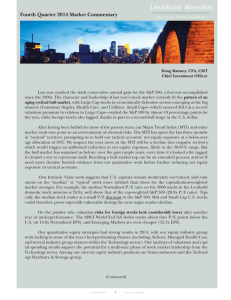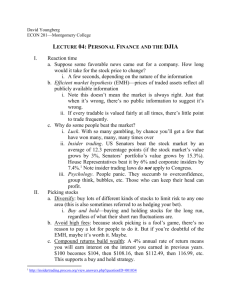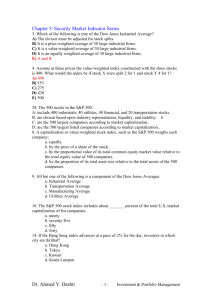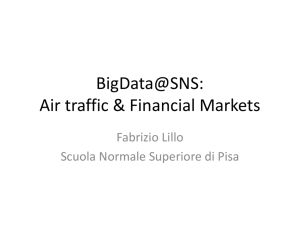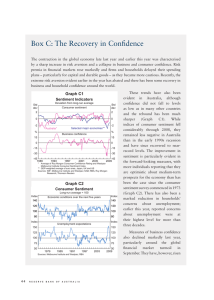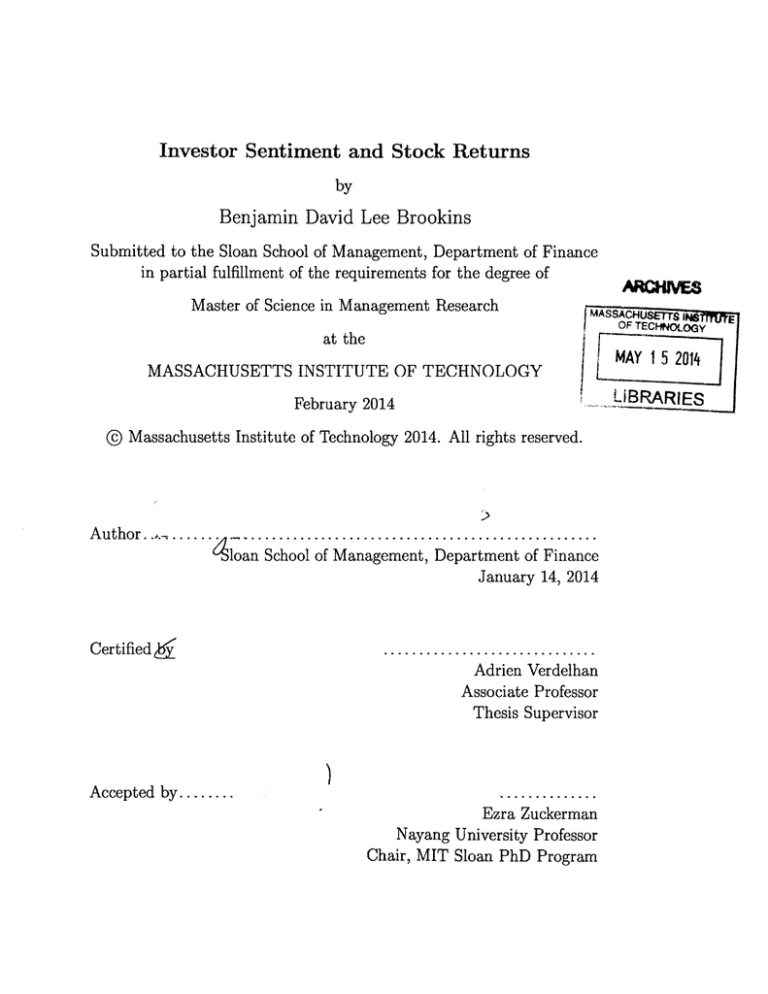
Investor Sentiment and Stock Returns
by
Benjamin David Lee Brookins
Submitted to the Sloan School of Management, Department of Finance
in partial fulfillment of the requirements for the degree of
Master of Science in Management Research
IMASSACHUSE-Ts,
I1
at the
MASSACHUSETTS INSTITUTE OF TECHNOLOGY
OF TEcHNOLOGy
AY 1 2014
LRARIES
February 2014
@ Massachusetts Institute of Technology 2014. All rights reserved.
Author... .....
loan SchoolJof Management, Department of Finance
January 14, 2014
Certified 4
Adrien Verdelhan
Associate Professor
Thesis Supervisor
Accepted by........
ARCHNES
)
Ezra Zuckerman
Nayang University Professor
Chair, MIT Sloan PhD Program
E
2
Investor Sentiment and Stock Returns
by
Benjamin David Lee Brookins
Submitted to the Sloan School of Management, Department of Finance
on January 14, 2014, in partial fulfillment of the
requirements for the degree of
Master of Science in Management Research
Abstract
Since Keynes coined the term animal spirits economists have been debating what
the real impact human psychology is on economic variables. The major challenge
in identifying these effects is the close ties between negative (positive) emotions
and poor (good) future real outlook. I exploit a historical weighting anomoly in a
widely cited US stock index to examine the impact of psychology on stock returns.
I first argue this is a plausibly exogenous shock, and compare this measure to other
measures found in the literature. I find that the measure doesn't seem to relate to
previous proxies for investor sentiment, however, when I examine survey measures
of interest rates and consumer confidence we find a relationship. I then examine
how sentiment affects the cross section of stock returns, consistent with predictions
I find that small stocks earn low subsequent returns when sentiment is low, and high
returns when sentiment is high.
Thesis Supervisor: Adrien Verdelhan
Title: Associate Professor
3
4
Contents
1 Introduction
11
2 Shock Description
13
2.1
Dow Jones Industrial Average . . . . . . . . . . . . . . . . . . . . . . 13
2.2
Value-weighted Index . . . . . . . . . . . . . . . . . . . . . . . . . . . 14
3 Relationship to Sentiment
17
3.1
Interest Rates . . . . . . . . . . . . . . . . . . . . . . . . . . . . . . .
18
3.2
Investor Sentiment and Consumer Confidence Indices . . . . . . . . .
19
3.3
Stock Returns . . . . . . . . . . . . . . . . . . . . . . . . . . . . . . .
20
4 Cross-Section of Stock Returns
21
4.1 Trading Strategy Construction . . . . . . . . . . . . . . . . . . . . . .
21
4.2
22
Returns and Risk . . . . . . . . . . . . . . . . . . . . . . . . . . . . .
5 Conclusion
25
A Figures and Tables
27
5
6
List of Figures
A-1 Dow Jones Price vs Value Weightings: December 31st, 2012
. . . . .
30
A-2 Frequency Distribution of Signals . . . . . . . . . . . . . . . . . . . . 31
A-3 Daily Returns on Size Sorted by Shock Percentile . . . . . . . . . . . 36
B
A-4 Daily Returns on - sorted on Shock Percentile . . . . . . . . . . . . 37
M
A-5 Weighting Rules for Trading Strategy . . . . . . . . . . . . . . . . . 38
A-6 Excess Returns above S&P 500
. . . . . . . . . . . . . . . . . . . . .
A-7 Cumulative Returns- Strategy vs. S&P 500
7
42
. . . . . . . . . . . . . . 43
8
List of Tables
A.1 Historical Components of DJIA 1939-Present . . . . . . . . . . . . . .
28
A.2 Characteristics of Constructed Index . . . . . . . . . . . . . . . . . .
29
A.3 LIBOR and Misleading Signals
. . . . . . . . . . . . . . . . . . . . . 32
A.4 Treasury Yield and Misleading Signals . . . . . . . . . . . . . . . . .
33
A.5 Consumer Confidence . . . . . . . . . . . . . . . . . . . . . . . . . . . 34
A.6 Baker-Wurgler Index and Components . . . . . . . . . . . . . . . . . 35
A.7 Daily Statistics - Summary of Moments . . . . . . . . . . . . . . . . . 39
A.8 Daily Statistics- Comparison of Tail Risk . . . . . . . . . . . . . . . . 40
A.9 Fama-French 3-factor Model . . . . . . . . . . . . . . . . . . . . . . . 41
9
10
Chapter 1
Introduction
Economists have long debated the effect of investor sentiment on asset prices. Classical finance theory says there is no place for behavioral theories in asset prices. In
contrast since at least Keynes (1936) coined the term "animal spirits" many authors
have considered the possibility that if sentiment affects a critical mass of market
participants than prices can depart from fundamentals. Classical finance theory argues that sentiment effects would be erased by fully rational traders arbitraging asset
prices departures from fundamental value. If these traders are unable to exploit this
arbitrage opportunity then sentiment effects are more likely to be observed.
The main empirical challenge of differentiating the behavioral and classical theories in asset pricing is the lack of exogenous variation. Our current proxies for
investor sentiment are insufficient in this regard because, as it is unclear if what we
are observing are changes in "animal spirits", which would be the behavioralists view,
or changes in expectations of future cash flows, a classical finance theorists view. I
aim to solve this empircal issue by proposing a new source of exogenous variation,
which is derived from an anomalous weighting scheme in the Dow Jones Industrial
11
Average (DJIA).
In this paper I present evidence that sentiment significantly effects the crosssection of asset prices, and argue that this effect is due to "sentiment shocks" which
are independent of news about future states of the world. I build on a concept that
dates back to at least Miller (1977) who argues that even if there are a large number
of rational participants in the market then if no one is willing to short sell there still
may be pricing anomolies.
There are several papers which do similar exercises to my paper, the most prominent probably being Baker and Wurgler (2006) and Stambaugh, Yu, and Yuan (2012).
My study differs from previous literature in one primary way, I propose a source of
exogenous variation and argue this can be viewed as an exogenous shock to sentiment. In doing so I demonstrate the causal effect of sentiment on asset prices. In
order to validate this as capturing a shock to sentiment, I show that it affects LIBOR rate (a survey based measure of interest rates), as well as consumer confidence.
Interestingly I find that it does correlate with traditional measures of consumer confidence used in the literature. I then derive a trading strategy in the same spirit as
Baker and Wurgler (2006) and Stambaugh, Yu, and Yuan (2012) and show I can
generate significant excess returns. Finally I show these returns cannot be explained
by a traditional factor models.
The rest of the paper is organized as follows: Section 2 describes the construction
of the index and data used, Section 3 provides evidence of how this new shock
relates to current measures of sentiment, Section 4 presents results and discussion,
and Section 5 concludes.
12
Chapter 2
Shock Description
2.1
Dow Jones Industrial Average
The Dow Jones Industrial Average (DJIA) is a price-weighted index comprised of 30
of the largest American corporations. It is the oldest and most cited index in the
United States. The DJIA is calculated as
Dowt =
zi Pit
Divisort
The Divisort is a time varying constant that adjusts everytime there is an stock
split, extraordinary dividend, spinoff for any component of the DJIA, or if there is
an addition or deletion from the index. The divisor is calculated such that the new
prices divided by the new divisor is the same as the old prices divided by the old
divisor. In math:
DEi ,
Po
Divisort Divisort_1
D
D
s
-+Divisort = Di'visort-
13
new
i_1
PtL
i d
This way of calculating an index runs counter to the way virtually every other
index in the world is calculated. The other two widely cited indeces in the US, the
NASDAQ composite, and the S&P 500, are both weighted by market capitalization
(value-weighted), as are most other indices economists reference. The reason that
the DJIA is different is for historic technology constraints.
When Charles Dow
started calculating the DJIA in 1896, it was calculated by hand. His goal was to
create an index that could be calculated quickly, and the easiest thing to do when
you observe prices is simply to add them up. Since the advent of computers, it is
obviously computationally simple to weight things by market capitalization, but Dow
has resisted such changes. In their words:
With little to gain, except maybe a reduction in criticism, we have no
reason to reweight the Dow to market capitalization. And there would be
a lot to lose: all that history is in price-weighted terms.
2.2
Value-weighted Index
I calculate the value weighted analog to the DJIA, a complete list of the stocks in the
Historical DJIA is displayed in Table A.1. The value weightings are quite different
from the price weightings as you can see in Figure A-1. For example at the end of
2012, even though IBM and General Electric have near identical market values, $214
billion and $218 billion respectively, IBM contributes more than nine times to the
DJIA returns than General Electric does. In our value weighted calculation they
both contribute the same amount to our value-weighted Dow.
My calculation of
the value-weighted Dow is completely analougous to the DJIA. I exclude ordinary
dividends, and only include extraordinary dividends in the return calculation. I refer
to this constructed index as VWIndext and the returns as VWRett.
14
Table A.2 displays summary statistics for the two constructed indices over various
time periods. In this analysis I will primarily focus on the time period from 19862012 for the LIBOR results since that is the period over which LIBOR is available.
I will focus on results from 1963-2012 for the results on stock market and treasuries
since that is when the better data becomes available. Additionally I will focus on
the index which excludes ordinary dividends, in order to parellel the DJIA as closely
as possible although all results are qualitatively similar when I use the index that
includes ordinary dividends. As you can see in Table A.2 the value-weighted index
and the price weighted index are very similar in terms of means, medians, and standard deviations from 1986-2012. Lastly, Figure ?? graphs the monthly deviations
of our index. Visually, you can see that it looks very random, there is some timevarying heteroskedasticity and the dispersion seems to be greatest during recessions,
but that isn't unexpected. Our deviation would mechanically be more disperse when
the crossectional standard deviation of stock returns is higher, this is the case during
recessions. The important thing to note is it doesn't seem that there are necessarily
more good or bad signals during recessions, it is only the 2nd moment that increases,
the distribution is still centered around zero.
All of these facts taken together tell us that the difference between the valueweighted and price-weighted index returns are plausibly exogenous. I construct variables of interest in our analysis is Devt,GoodSignalt and BadSignalt. Devt is simply
the deviations in returns from the value-weighted index and the DJIA. I define
Dev = VWRett - DJIAt
This tells us how much of the return is due to the unconventional weighting
scheme. I further define variables in the spirit of trying to capture something like
15
good and bad signals. The most crude way to do this is simply to define:
GoodSignal
1 {(DJIAt > 0) n (VWRett < 0)}
(2.1)
BadSignalt
1 { (DJIAt < 0) n (VWRett > 0)}
(2.2)
Similarly
GoodSignalt simply means that when I observe a positive quoted return even
though the return on wealth is negative, BadSignalt is analogous. Over the time
period from 1982-2012 GoodSignalt occurs 5.1% of the time and BadSignalt occurs
4.4% of the time.
16
Chapter 3
Relationship to Sentiment
Although the majority of our discussion has focused this Devt the majority of our
tests actually run the specification
Ayt =
&+
/ 1VWRett
1
+
2
PWRett- 1
6Xt + Et
The reason this is, is because I want to control for the value weighted return in
our regressions. If I run the specification
Ayt = a* + i*VWRett_1 + f*Devt1 ± 6Xt* + Et
The coeffecient value becomes a little less natural to interpret. Our Ho is that
the price-weighted return conditional on the value weighted return shouldn't matter.
Therefore I can test this directly with Ho : 02
17
=
0.
3.1
Interest Rates
Table A.3 presents estimates of with Xt being the possible conflicting states. I
control for all 4 possible states in these regressions, even though the both the price
and value weighted moving in the same direction are not presented. As you can
see the coeffecients on the returns are significant especially at the longer horizons.
This tells us that bankers when reporting LIBOR put weight on the price weighted
index, especially at longer horizons. If you think of the DJIA as a type of "economic
indicator", it also makes sense that these effects are primarily present at longer term
horizons since we know better the economic conditions at the present, and therefore
the DJIA is providing information about future economic conditions.
The most stark coeffecients in Table A.3 are
#3 and
34.
When a good signal is
recieved, as manifested through the price-weighted being positive return when the
value-weighted return was actually negative, LIBOR increases positively and significantly at the 3-month horizon onward. Furthermore these jumps are economically
large ranging from .6 - 1.1 basis point. This estimates represents between 25 - 35% of
the mean absolute daily change in LIBOR rates. Finally you see that the coeffecient
on
#4is
zero. This is surprising at first, since one may not expect people to behave
assymetrically. However this result is consistent with previous ideas that people react
positively to good signals and do not react to bad signals.
Table A.4 presents the same regressions except for treasury yields instead of
LIBOR. The contrast is stark. There are essentially no significant coeffecients. One
might be concerned that even though individually they are not significant, that is
due to the large standard errors generated by the multicollinearity. Examining the
F-stat for this regression we see that it is small and insignificant everwhere, telling
us that the model is jointly insignificant. As robustness As a robustness check I ran
18
regressions where we included dividends instead of excluding dividends, qualitatively
the results from both the LIBOR and treasury yield analysis did not change. This is
a surprising result in many ways considering the close relationship between LIBOR
and treasury yields. However, given that we are trying to pick up the "human error"
component of the surveys, it seems like I may have done just that.
3.2
Investor Sentiment and Consumer Confidence
Indices
I convert our daily series to a monthly series by taking difference between the monthly
returns of the DJIA and the value-weighted analog. I do this to examine a wider class
of data including the commonly cited indicators of investor sentiment, and consumer
confidence.
Table A.5 displays a regression of the monthly changes in consumer confidence
on the monthly deviations of the DJIA. This is contemporaneous, since the surveys
are completed at the end of the month, the timing matches pretty well. As you
can see there is a relatively strong relationship and fairly robust to the inclusion
of other possible variables. Additionally the F-stat is reasonably large in several of
the regressions. I think this measure could be used as an instrument for consumer
confidence in future research projects.
If we examine the relationship between our measure and the Baker-Wurgler index,
in Table A.6,we essentially see no relationship. Additionally if we examine the relationship between our shock to sentiment and the components of the Baker-Wurgler
index, again there is no consistent relationship. One thing that you might notice
is that the F-stat is relatively higher for the flexible polynomial spacification. The
19
primary significant coeffecients in that specification are the 2nd and 4th moments.
I interpret this to have more to do with the correlation between the dispersion of
the second moment of our index and the likelihood of recessions than having some
exogenous relationship. The fact that there is no relationship between traditional
measures used in the literature and my measure of shock would be more troubling if
there wasn't a strong relationship to either consumer confidence or LIBOR. It does
seem this measure affects people's feelings about the future, even if it doesn't effect
traditional measures of investor sentiment. One possible explanation, is that while
my measure is really capturing the "animal spirits" portion of sentiment, while previous measures are loading much more on changes in expectations about the future.
Another possible explanation, is that this measure of sentiment is simply not affecting investors, it is only affecting the more general public. I think that argument is
largely refuted by the LIBOR survey results, LIBOR survey takers are by all accounts
sophisticated market participants, and Section ??'s results on stock returns.
3.3
Stock Returns
Figure A-3 plots percentile deviations agains the expected returns of Small-Big and
Small-Medium Portfolios. There is clearly a strong relationship between these two
variables, and it is not as if this only exists at the extremes of the distribution. It is
fairly uniformly decreasing throughout the distribution. If you look at the same graph
for Growth-Value or Growth-Core you don't see nearly as strong as a relationship.
For the rest of the paper we focus on the Small-Big portfolio, although the same
results are qualitatively the same if you focus on the Medium-Big portfolio.
20
Chapter 4
Cross-Section of Stock Returns
4.1
Trading Strategy Construction
I construct 6 different trading strategies, but they are all based off of the same idea.
The basic idea is to invest in small stocks when sentiment is high (as proxied for by
our measure) and invest in large stocks when sentiment is low. We construct two
types of strategies, the first is a simple long strategy. In each period we either buy a
portfolio of small stocks, or a portfolio of large stocks. The second strategy is a nocost strategy, if sentiment is high we buy a portfolio of small stocks and concurrently
short a portfolio of small stocks, then reverse the position when our measure of
sentiment is low, shotrting small stocks and longing large stocks. For each type of
strategy we examine 3 types of portfolios. The first is simply declaring zero to be the
cutoff, we are net long small stocks in Devt > 0. The second strategy is doing the
same simple strategy, but estimating at which point we should switch from buying
small stocks by using the regression line in Figure A-3. Finally we apply a check
function, to give more weight to those observations far away from the optimal cutoff.
21
Each strategy we are on average long one unit. In the first two weighting schemes
we are always long one unit (and short one unit if we are using a no cost strategy).
The weights are constructed that on average we are long one unit, and can be long
anywhere from 0 to 2 units. The weighting kernel chosen in the weighting scheme
is largely arbitrary and just trying to give deviations far away from the cutoff more
weight. Figure A-5 displays graphically what these weighting schemes look like.
4.2
Returns and Risk
Table A.7 displays the moments of the trading strategy as well as the estimate of
a and 0 from a simple CAPM model. The S&P 500 is used as the return on the
market for comparison and in the regressions.
As you can see the first two long
strategies are very similar in terms of standard deviation, skewedness, and kurtosis
but generate significantly higher returns that the S&P 500. The third strategy is
more risky, but not incredibly so in terms of standard deviation. Your strategy has
about 25% higher a standard deviation, but recieves almost 4x the return on the
market. However there is much higher kurtosis than the market. The next three
strategies are so called "no-cost" strategies. Notice first of all, that all three of their
,6 is essentially zero. This means the theoretical return should be roughly in line with
the risk free rate. However the returns far exceed this and even exceed the returns
of the S&P 500. One might be worried about the large kurtosis involved in taking
these strategies, but notice the skew of the distribution is positive, it suggests these
tail events are actually very positive windfalls for you and not very negative events.
Looking at Table A.8 we see this is indeed the case.
Table A.9 show that these
returns are also not due to loading on some other risk factor! is still very positive
and significant. The results are robust to including momentum as a fourth factor.
22
Figure A-6 shows our returns through time. The vast majority of years our
strategies outperform the market. The one exception to this is the naive no-cost
strategy. On average it still outperforms the market, and it is a zero-beta asset, so
comparing those to the S&P are unfair to begin with.
23
24
Chapter 5
Conclusion
My results are largely consistent with effecient markets, although it seems like we
can construct this trading strategy of investor sentiment, when we actually go and
attempt to implement it using liquid and large markets, the relationship dissappears. Likely the excess returns we are seeing are due to limits of arbitrage and/or
transaction costs. My measure does effect large and important variables LIBOR and
consumer confidence and could be used as an instrument for consumer confidence in
the future.
25
26
Appendix A
Figures and Tables
27
Table A.1: Historical Components of DJIA 1939-Present
Past Components
Entry Date
Company Name
Current Components
Entry Date
Company Name
Alcoa *
American Express
Boeing
Bank of America
Caterpillar
Cisco
Chevron *
Du Pont
Disney
General Electric
Home Depot
Hewlett-Packard
IBM
Intel
Johnson and Johnson
JPMorgan
Coca Cola
McDonalds
3M *
Merck
Microsoft
Pfizer
Procter and Gamble
AT&T Inc *
Traveler's Company *
UnitedHealth Group
United Technologies *
Verizon
Wal-Mart
Exxon Mobil *
6/1/1959
8/30/1982
3/12/1987
2/19/2008
5/6/1991
6/8/2009
2/19/2008
3/4/1939
5/6/1991
3/4/1939
11/1/1999
3/17/1997
6/29/1979
11/1/1999
3/17/1997
5/6/1991
3/12/1987
10/30/1985
8/9/1976
6/29/1979
11/1/1999
4/8/2004
3/4/1939
11/1/1999
3/17/1997
9/14/2013
3/4/1939
4/8/2004
3/17/1997
3/4/1939
Exit Date
9/22/2008 9/14/2012
Kraft Foods
6/8/2009
General Motors
3/4/1939
American International Group 4/8/2004 9/22/2008
Altria Group *
10/30/1985 2/19/2008
3/4/1939 2/19/2008
Honeywell International *
4/8/2004
3/4/1939
ATT Corp
4/8/2004
3/4/1939
Eastman Kodak
4/8/2004
7/3/1956
International Paper
3/4/1939 11/1/1999
Goodyear
3/4/1939 11/1/1999
Union Carbide
3/4/1939 11/1/1999
Sears
3/4/1939 3/17/1997
Westinghouse Electric
3/4/1939 3/17/1997
Texaco *
3/4/1939 3/17/1997
Bethlehem Steel
3/4/1939 3/17/1997
Woolworth
3/4/1939 5/6/1991
Navistar *
3/4/1939
5/6/1991
USX *
12/16/1988 5/6/1991
Primerica *
3/4/1939 12/16/1988
American Can Company *
3/4/1939 3/12/1987
Inco LTD *
6/1/1959 3/12/1987
Owen-Illinois
3/4/1939 10/30/1985
General Foods
3/4/1939 10/30/1985
American Brands *
3/4/1939 6/29/1979
Chrysler
Esmark *
Mansville Corporation
Anaconda Copper
American Smelting
Corn Products
National Steel
National Distillers
Loews Incorporated
28
6/1/1959
3/4/1939
6/1/1959
3/4/1939
3/4/1939
3/4/1939
3/4/1939
3/4/1939
6/29/1979
8/30/1982
8/9/1976
6/1/1959
6/1/1959
6/1/1959
6/1/1959
7/3/1956
Table A.2: Characteristics of Constructed Index
Value-Weighted Index
Excluding Dividends Including Dividends DJIA
Panel A: 1986-2012
Mean
Median
.0381
.0455
.0488
.0554
.0381
.0519
Standard Deviation
1.200
1.200
1.162
Corr(VW, DJIAt)
.97
.97
-
Panel B: 1962-2012
Mean
Median
Standard Deviation
.0252
.0218
1.046
.0398
.0348
1.045
.0278
.0343
1.024
Corr(VWt, DJIAt)
.97
.97
-
Panel C: 1939-2012
Mean
Median
.0212
.0229
.0374
.0407
.0287
.0392
Standard Deviation
.971
.970
.953
Corr(VWt, DJIAt)
.97
.97
-
29
Figure A-1: Dow Jones Price vs Value Weightings: December 31st, 2012
22
SValue
10
Weighting
SPrice Weighting
B
0
30
Figure A-2: Frequency Distribution of Signals
25
EGood SIgnals
mBad Signals
1
10
0a imm
1986
1998
I
1990
I.
1992
, ,I
1994
1996
1998
2000
2002
2004
2006
|
II
2009
2010
II
II
31
2012
Table A.3: LIBOR and Misleading Signals
Maturity
1 month 3 month 6 month 9 month 12 month
VWRett
(t - stat)
0.0025
(0.80)
0.0054* 0.0077** 0.0070** 0.0080**
(2.19)
(2.13)
(2.40)
(1.86)
PWRett
-0.0029
-0.0046 -0.0073* -0.0068* -0.0085*
(-0.84)
(-1.34)
GoodSignalt 0.0025
BadSignalt
(-1.86)
(-1.70)
(-1.91)
0.0056* 0.0082** 0.0078** 0.0111**
(0.78)
(1.74)
(2.35)
(2.01)
(2.52)
0.0000
-0.0007
-0.0026
-0.0035
-0.0029
(0.01)
(-0.28)
(-0.86)
(-1.04)
(-0.81)
*, **, and *** mean significant at the 10%, 5% and 1% level respectively.
32
Table A.4: Treasury Yield and Misleading Signals
1 year
3 year
5 year
10 year
Maturity
3 month 6 month
VWRett
(t - stat)
-0.0069
(-1.38)
-0.0052
(-1.20)
-0.0033 -0.0013 -0.0015 -0.0014
(-0.91) (-0.35) (-0.43) (-0.40)
PWRett
0.0072
(1.34)
0.0050
(1.13)
0.0040
(1.07)
GoodSignal -0.0024
(-0.53)
0.0011
(0.31)
0.0015
(0.45)
0.0008
(0.25)
-0.0003 -0.0070* -0.0034 -0.0046 -0.0043
(-1.70) (-0.89) (-1.31) (-1.38)
(-0.09)
BadSignalt
0.0008
(0.17)
0.0015
(0.37)
F - stat
(p - value)
0.82
(.53)
0.66
(.65)
-0.0035 -0.0032 -0.0033 -0.0023
(-1.04) (-1.04) (-1.08) (-0.80)
1.57
(.17)
1.27
(.27)
1.28
(.27)
1.04
(.39)
*, **, and *** mean significant at the 10%, 5% and 1% level respectively.
33
Table A.5: Consumer Confidence
ACCt = a + O31DJIAt + 0 2VWRett + JXt + Et
Maturity
(1)
Devt
-1.5045***
(-3.07)
(2)
(3)
PWRett
(t - stat)
1.5728***
(3.28)
1.6481***
(3.25)
VWRett
-1.2745*** -1.3241*** -0.5882* -0.5991
(-2.66)
(-2.67)
(-1.65) (-1.62)
(4)
(5)
0.6552* 0.7419*
(1.77)
(1.82)
State Controls
No
No
Yes
No
Yes
Macro Controls
No
No
No
Yes
Yes
F-Stat
9.4197
6.5871
2.7477
16.0591 14.0092
*, * and *** mean significant at the 10%, 5% and 1% level respectively.
Regressions are monthly from 1978-2012. State controls refer to the Good Signal
State, Bad Signal State, both the Value-weighted and Price-weighted indices rising,
and both the Value-weighted and price-weighted indices declining.
34
0.0031
3.8529
-0.0071
18.8087
-0.0175
13.107
-0.0300***
2.0637
-0.0212
3.4489
-0.0216
2.4075
-0.3226
1.4331
-0.3868
8.5107
-0.3788
7.4628
0.1188
2.8251
1.9506
9.4715
1.8449
7.2791
2.1144
1.6716
-0.9095
1.041
-2.0158** 4.0686**
2.2356
3.7248
-2.1754** 3.8646*
2.1778
2.0965
-0.004
0.26
0.0333
19.1952
0.0359
11.971
0.0116
0.3041
0.0306
11.2632
0.0334
7.2505
01
F-Stat
01
F-Stat
01
F-Stat
State Controls
Flexible Polynomial
All
'Index is orthogonalized to macro factors. State Controls means controlling for the four possible states of
the world, DJIA increases and value-weighted index decreases, DJIA decreases and value-weighted index
increases, both the DJIA and value-weighted indices decrease, and both the DJIA and value-weighted indices
increase. The flexible polynomial is a 4th degree polynomial in Devt.
0.0147
5.0653
-0.0288***
4.2044
-0.3491
1.3009
-0.2454
4.248
2.0448
1.7722
-0.7968
2.6135
-0.0006
0.0049
0.0133
0.0896
Turn
SE
#1
F-Stat
BW-Index BW-IndexL Div Prem IPO Vol IPO Ret CEF Disc
Baseline
Controls
Ayt = a + /31DJIAt + 02 VWRett + 6Xt + ct
Table A.6: Baker-Wurgler Index and Components
This model estimates the following specification
0
-0.31
-0.2-
-0.1
0
0.1
O0
10
0.2
c
0.8
0(90
Go
0.4
0.6
Shock Percentile
0
009 0L
o
00
1
06
E
.
2
.
-0.3'
0
-0.2-
-0.1
0
0.1
o
0
0
0.2
0
0
C)0
0)
0
0.6
0.4
Shock Percentile
00 0%
0
0
0.8
0~)
000-
(0
0
1
simple linear regression of Rett = a + /ShockPercentilet_1 + ct
This graph shows the Dev_1 graphed against the returns of the Small minus Big portfolio, and the Small
minus Medium portfolio in period t. The x-axis is shock percentiles with 0 being the DJIA underperforming
the Value-weighted index, and 1 being the DJIA outperforming the value-weighted index. The data is split
into 50 bins with the dots representing the average return for that day. The line is the regression line of a
U,
E
E
0.2-
0.21
G
0.3 K
0.3 b 0
0
0.4
0.4
Figure A-3: Daily Returns on Size Sorted by Shock Percentile
0
0.3
0.4
0.5 0.6
Shock Percentile
00
0
0.7
0.8
O0p-0)
0
0.9
0cc)
0
0
>D
-. 1 [0
-0.05-
0-
0
0
0
0.1
0.2
0.3
C
0 00 O 0
000
0
0
C
0
0
0
0.7
0
O
0.8
0 00
) 0 000000(D0
0.4
0.5
0.6
Shock Percentile
O00QQ
These are the same graphs of the previous page but sorting on B/M instead of size.
0
-0.25
-0.2
0.2
000-X
0D 0 0
C>)
-0.3 -
0.1
0
o
0.05-
0.1 -
-0.15 -
-
00
E
0.15-
-0.2 -
9 -0.1
E
0.2 -
0.3
0.2-
0.25-
B
Figure A-4: Daily Returns on - sorted on Shock Percentile
M
0.9
0
0 000
0
1
0
D)
Figure A-5: Weighting Rules for Trading Strategy
Simple Trading Strategy
100
'D
75
---------------------
-
80
60
40
2
20
-----------------
------
0
)
M
0.5
1
Optimal Cutoff
100 ---------------------80
60
40
20
--- -------- --------
0
0
0.5
1
Weights
200
"D
150
100
0
50
0
0
--------------------0.5
1
Shock Percentile
The blue dashed line represents the percentage of the portfolio held in the large
stocks as a function of the shock percentile. Likewise the redline dotted represents
the percentage of the portfolio held in small stocks. In the case of zero cost portfolios,
the blue dashed line represents the amount we hold in the Big - Small Portfolio, while
the red dotted line represents the amount we hold in the Small - Big portfolio.
38
3.74% 0.02
9.54% 0.04
13.43% 0.08
3.72
9.49
13.47
0.75
0.74
1.01
0.97
0.97
1.27
1.16
0.70
2.06
-0.15
-0.78
-1.88
-0.63
The simple long strategy involves longing one dollar of large stocks if my measure of sentiment is low the
previous day and longing one dollar of small stocks if my measure of sentiment is high. The simple long
short strategy involves longing one dollar of the largest stocks and shorting one dollar of the small stocks if
sentiment is low, and doing the opposite if sentiment is high. The optimal cutoff is estimated via regression
at which point holding small stocks outperforms holding large stocks, at point I reverse the position then,
instead of just at the 0 value. Optimal Cutoff with weights is when I put increasing weights on things away
from the cutoff, taking bigger bets in more extreme events.
All info is from July 3rd, 1962 - December 31st, 2012.
No Cost Strategies
Simple Long-Short Strategy
Optimal Cutoff Long-Short
Optimal Cutoff Long-Short (w/weights)
6.51
9.40
12.20
One-way Strategies
Simple Long Strategy
4.04% 0.81
Optimal Cutoff Long Strategy
6.94% 0.82
Optimal Cutoff Long Strategy (w/weights) 9.34% 0.95
1.03
27.2
27.8
107.6
15.0
25.2
93.5
24.0
Mean (bps) Standard Deviation (%) Skewness Kurtosis
3.08
3
0.00% 1.00
Market Baseline
S&P 500
aa
Table A.7: Daily Statistics - Summary of Moments
1%
5%
95% 99% Max
-20.5 -2.70 -1.52 1.54 2.77 11.6
Min
No Cost Strategies
Simple Long-Short Strategy
Optimal Cutoff Long-Short
Optimal Cutoff Long-Short (w/weights)
-5.18 -1.82 -1.05 1.16 2.03 16.1
-9.25 -1.78 -0.98 1.2 2.04 16.1
-18.5 -2.34 -1.09 1.59 3.09 32.2
One-way Strategies
Simple Long Strategy
-10.4 -2.67 -1.41 1.44 2.72 11.5
Optimal Cutoff Long Strategy
-19.7 -2.66 -1.37 1.46 2.66 10.5
Optimal Cutoff Long Strategy (w/weights) -39.3 -3.44 -1.54 1.8 3.9 15.0
Market Baseline
S&P 500
Table A.8: Daily Statistics- Comparison of Tail Risk
Table A.9: Fama-French 3-factor Model
a
One-way Strategies
Simple Long Strategy
(Standard Error)
fOMkt
OSMB
OGMV
4.0995 0.8864
0.5571 0.2161
(1.4791) (0.0783) (0.0946) (0.0965)
12.0287
(2.2851)
Optimal Cutoff Long Strategy
Optimal Cutoff Long Strategy (w/weights)
No Cost Strategies
Simple Long-Short Strategy
1.0918
(0.121)
0.5774
0.372
(0.1462) (0.1491)
19.5952 0.9937
0.7609 0.4955
(4.4505) (0.2357) (0.2847) (0.2904)
7.9291 -0.3849 -0.0217 -0.0119
(2.5142) (0.1331) (0.1609) (0.1641)
Optimal Cutoff Long-Short
25.4946 -0.0604 -0.113
-0.2282
(5.2085) (0.2758) (0.3332) (0.3399)
Optimal Cutoff Long-Short (w/weights)
39.1664 -0.3335 -0.1057 0.0569
(7.4645) (0.3953) (0.4776) (0.4871)
The Fama-French 3 factor model is estimated at an annual frequency using returns
and factor data from 1963-2012.
41
Figure A-6: Excess Returns above S&P 500
Simple Long Strategy
Simple Long-Shot Strategy
100
/A
50:-
-50
lo20
1970
1990
1990
200
2010
Long-Short Strategy with Cto Rle
190
100-o\
50-f
50-
0
-50
\
V-V
1970
1980
1990
with Cutol
Long Strategy
2000
0
2010
1970
Rule and Weights
1980
1990
2000
2010
Long-Short Strategy with Cutoff Rule and Weights
150
300
100-
100-
AlV
s-"0A
1970
198
Ao- J,I ,~k
\ v\,
V
1990
200
1970
2010
1980
1990
I
LV
2000
_j
2010
The excess returns displayed are those from following the strategies described in
Table A.7 and Figure A-5. The strategies used are looking at the trading in the
largest decile and smallest decile. All figures are qualitatively similar if we trade in
the largest decile and median decile (and vice versa). Excess returns are defined as
those above the S&P 500.
The results on the left hand side are little more difficult to interpret due to the fact
that it is a long-short portfolio with a zero net position. On average (and everywhere
for the top two panels) the weightings are such we are investing with no leverage.
None of the returns reflect the transaction costs associated with these strategies.
42
Figure A-7: Cumulative Returns- Strategy vs. S&P 500
Simple Long-Short Strategy
Simple Long Strategy
x 105
10"
1.56000
I'
-
1
400
0.5 2000
0-
8
1970
1990
1990
2000
2010
Long Strategy with Citot Rule
x 108
--
0
1970
1980
1990
Long-Short Strategy with
x log
15
2000
Citot
2010
Rule
610-
452-
01
1970
7
x 10
15
1980
Long Strategy
.
,
1990
2000
01
2010
with Ctog Rule and Weights
1970
x 100 Long-Short Strategy
15
10 -
10-
5-
5-
1970
1990
1990
2000
1980
0-
2010
1970
1980
1990
with Cut
1990
2000
2010
Rule and Weights
2000
2010
The returns displayed are those from following the strategies described in Table A.7
and Figure A-5. The strategies used are looking at the trading in the largest decile
and smallest decile. All figures are qualitatively similar if we trade in the largest
decile and median decile (and vice versa). The returns are graphed against the
returns on the S&P 500, the S&P 500 returns are in shown in blue.
The results on the left hand side are little more difficult to interpret due to the fact
that it is a long-short portfolio with a zero net position. On average (and everywhere
for the top two panels) the weightings are such we are investing with no leverage.
None of the returns reflect the transaction costs associated with these strategies.
43
44
Bibliography
Baker, Malcolm and Jeffery Wurgler. 2004. A Catering Theory of Dividends. Journal
of Finance 59(3) 1125-65.
Baker, Malcolm and Jeffery Wurgler. 2006. Investor Sentiment and the CrossSection of Stock Returns. Journal of Finance 61(4) 1645-80.
Cochrane, John. 2006. Asset Pricing.Princeton University Press.
Dow Jones Indices. 2010. Dow Jones Industrial Average Historical Divisor Changes.
Dow Jones Indices. 2012. Five Questions about the Dow you Always Wanted to
Ask.
Hirshleifer, David and Tyler Shumway. 2003. Good Day Sunshine: Stock Returns
and the Weather. Journal of Finance.58(3) 1009-32.
Keynes, John M. 1936. The General Theory of Employment, Interest, and Money.
MacMillan.
Miller, Edward. 1977. Risk, Uncertainty, and the Divergence of Opinions. Journal
of Finance. 32(4) 523-48.
Tetlock, Paul. 2007. Giving Content to Investor Sentiment: The Role of Media in
the Stock Market. Journal of Finance. 62(3) 1039-68.
45


